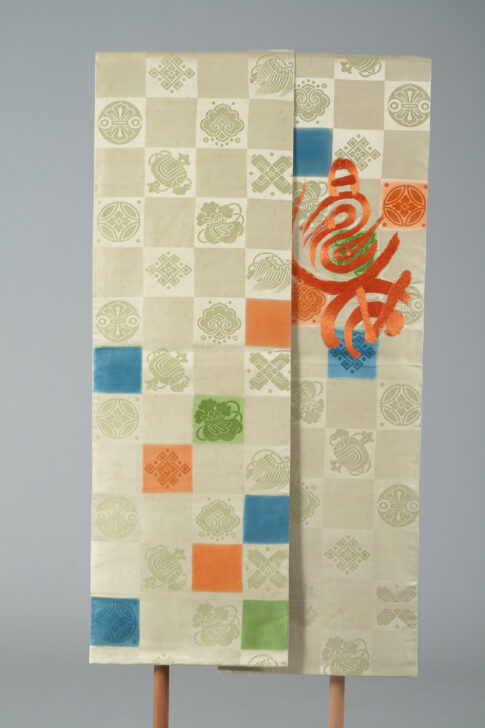Obi
Japanese

Description
Haori with designs of character kotobuki (longevity)
Japan
Sho ̄wa period (1926–1989)
1940s–50s
Black crepe silk with wax resist design with red and white silk twill lining
Gift of Howard and Patricia Yamaguchi, 2005/1.352
Obi with designs of character kotobuki (longevity)
Japan
Sho ̄wa period (1926–1989)
20th century
Silk brocade with embroidery
Gift of Howard and Patricia Yamaguchi, 2013/2.372
Obi began as modest cloth belts that held kimono in place.
By the twentieth century, they were regarded as one of the
fundamental decorative components of traditional women’s
dress. Tied in the back to form elaborate knots, they are
essential to produce the straight-lined silhouette of kimono.
Haori originated as men’s jackets but were adopted by women
after regulatory laws were loosened during Japan’s period
of Westernization in the nineteenth century. At first, they
carried connotations of education and artistic training but
later became the de facto outerwear for women who dressed
in kimono outside the home. Since the mid-twentieth century,
most women wear haori only for formal events.
Both garments include the character kotobuki, meaning
happiness, celebration, or longevity. The haori presents the
character in various styles and colors rendered in the yu ̄zen
dyeing technique, which uses rice-paste as a resist. In the
woven brocade of the obi, the kotobuki character is paired with
other symbols, such as scrolls signifying knowledge, and lucky
mallets said to grant wishes.
Object pictured is the obi.
Subject Matter:
This is a Nishijin, Fukuro Obi. in Otaiko Gara.
The different colored squares, Ichimatsu mon, contain interwoven Takara Zukushi motifs that depict precious objects such as sacred scrolls, lucky bags, and the mallet of luck. This design originated in China and has been used as a motif since the late sixteenth century to symbolize happiness and prosperity. The Chinese character “Kotobuki,” embroidered in silver and orange, signifies longevity and appears in several different versions.
Nishijin-ori textiles were developed in the Nishijin area of Kyoto city and has dominated the production of high-quality woven textiles since the fifteenth century.
Fukuro Obi is double-layered single sided obi in which two separately woven surfaces and back pieces of cloth are stitched together. This type of obi is typically only worn at weddings or other formal occasions. Gara refers to the orientation, arrangement, and surface area of the patterns and pertains to a specific trend and obi tying style. The patterning in the Otaiko gara type is minimal. A few concentrated spots of patterned motif lie on the obi while the rest is left blank. This style was invented during the Edo period (1615-1868) by the female entertainers in Fukugawa, an entertainment district in present-day Tokyo.
Physical Description:
Pale green silk Fukuro (single sided) obi with dyed green, blue, and orange squares and seven embroidered Chinese characters “Kotobuki” which signifies longevity.
Usage Rights:
If you are interested in using an image for a publication, please visit https://umma.umich.edu/request-image/ for more information and to fill out the online Image Rights and Reproductions Request Form.